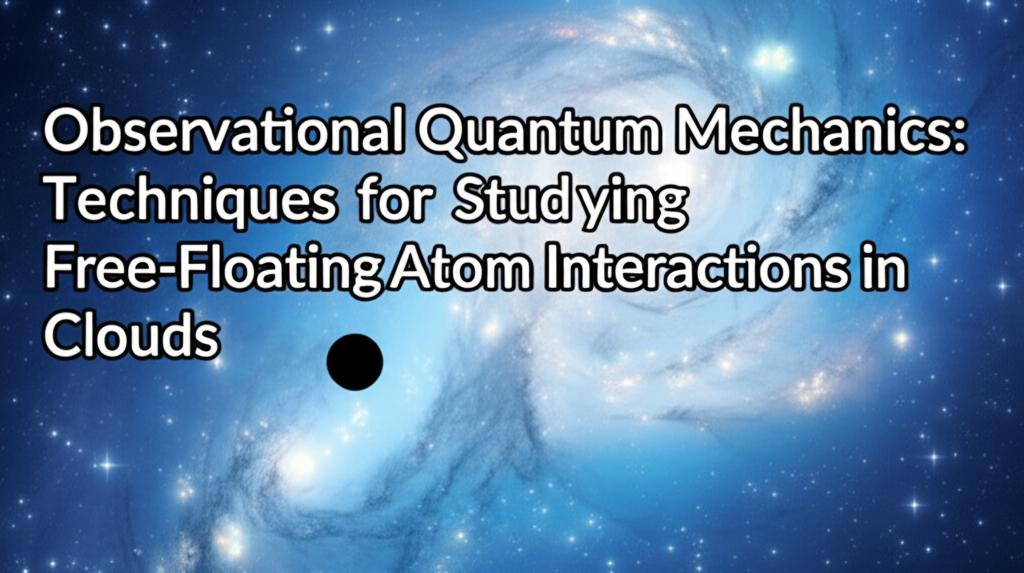Unveiling the Quantum Dance: New Windows into Free-Floating Atom Interactions
Scientists are developing and refining innovative techniques to observe the intricate interactions of free-floating atoms within clouds, pushing the boundaries of our understanding of quantum mechanics. These advancements allow for the direct visualization of behaviors previously only predicted by theory, opening new avenues for exploring fundamental physics and developing quantum technologies.
Cooling Atoms to a Standstill to Witness Quantum Phenomena:A cornerstone of studying these atomic interactions involves cooling atoms to ultracold temperatures, often near absolute zero. At these extreme temperatures, the quantum-mechanical properties of atoms become dominant. Techniques like laser cooling in magneto-optical traps, followed by evaporative cooling, are employed to achieve these conditions. This allows researchers to create unique states of matter, such as Bose-Einstein Condensates (BECs) and Fermi gases, where atoms behave in concert, exhibiting macroscopic quantum phenomena.
Microscopy and Imaging: Capturing Atoms in Action:Recent breakthroughs in imaging have been pivotal. "Atom-resolved microscopy" is a technique that is allowing scientists to capture images of individual atoms interacting freely in space. This method typically involves:
- Trapping: Atoms are initially confined in a loose trap, often created by laser beams, allowing them to interact freely.
- Freezing: A "light lattice" or "pinning lattice" is then rapidly switched on, effectively freezing the atoms in their positions.
- Illumination: A second laser illuminates the trapped atoms, causing them to fluoresce. The emitted light reveals their precise locations and interactions.
This approach has enabled the first direct images of phenomena like bosons bunching together and fermions forming pairs in free space – behaviors fundamental to quantum mechanics.
Advanced Imaging Algorithms:To overcome the challenges of imaging at such small scales, scientists are also developing sophisticated image-correction techniques. New algorithms, sometimes employing principles similar to eigen-face recognition coupled with smart masking, can significantly reduce interference fringes and improve the clarity of images. These advancements lead to more accurate calculations of crucial parameters like optical density, temperature, size, and density of the atom clouds.
Quantum Gas Microscopy:Quantum gas microscopy is another powerful platform for studying atom-atom interactions, particularly in lattice structures. This technique allows researchers to probe Hamiltonians like the Bose-Hubbard and Fermi-Hubbard models with various atomic species. Recent developments include the creation of Erbium Dipolar Quantum Gas Microscopes, which enable the study of dipole-dipole interactions. Erbium offers advantages due to its stable isotopes, large magnetic dipole moment, and rich Feshbach spectrum, providing greater control and flexibility.
Observing Exotic Quantum Behaviors:These advanced observational techniques are leading to groundbreaking discoveries:
- Quantum Tornadoes: Physicists have directly observed the interplay of interactions and quantum mechanics in rapidly rotating quantum fluids of ultracold atoms. These experiments have visualized how an initially round cloud of atoms deforms into a thin, needle-like structure, demonstrating a crossover from classical to quantum behavior.
- Pauli Blocking and Transparency: In dense, ultracold atom clouds, the Pauli exclusion principle can prevent atoms from scattering light as they normally would. If all low-energy quantum states are occupied, atoms cannot change their state by scattering a photon, making the cloud more transparent. This effect, predicted decades ago, has now been experimentally observed.
- Edge States: Researchers have directly observed atoms flowing without resistance along the boundary of an ultracold atomic cloud, even when obstacles are introduced. This phenomenon, known as an "edge state," is analogous to how electrons can flow without friction along the edges of certain exotic materials and could have implications for super-efficient energy and data transmission.
- Quantum Entanglement in Atomic Clouds: Experiments have successfully achieved quantum entanglement between two spatially separated ultracold atomic clouds (Bose-Einstein condensates). This opens possibilities for advancing quantum computing, simulation, and metrology, which rely on creating and controlling large ensembles of entangled particles.
Atom-resolved imaging techniques are enabling scientists to probe a range of quantum correlations, such as those near a quantum phase transition and two-particle correlations between fermions. By studying systems with a varying number of atoms (from tens to hundreds), researchers can address fundamental questions about how many particles are needed to replicate the behavior of a macroscopic system.
Space-Based Research:The study of ultracold atoms is also extending into space. Facilities like NASA's Cold Atom Lab on the International Space Station allow for the creation of BECs and the study of their properties in microgravity. The absence of strong gravitational pull enables longer observation times and potentially colder temperatures, offering unique opportunities to explore new quantum phenomena.
These ongoing advancements in observational techniques are providing unprecedented insights into the quantum world of free-floating atom interactions. By directly visualizing and manipulating these tiny particles, scientists are not only confirming long-held theories but also paving the way for new discoveries and the development of transformative quantum technologies.

